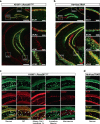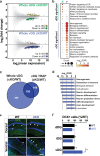Serotonin receptor 4 in the hippocampus modulates mood and anxiety
- PMID: 33441982
- PMCID: PMC8275670
- DOI: 10.1038/s41380-020-00994-y
Serotonin receptor 4 in the hippocampus modulates mood and anxiety
Abstract
Serotonin receptor 4 (5-HT4R) plays an important role in regulating mood, anxiety, and cognition, and drugs that activate this receptor have fast-acting antidepressant (AD)-like effects in preclinical models. However, 5-HT4R is widely expressed throughout the central nervous system (CNS) and periphery, making it difficult to pinpoint the cell types and circuits underlying its effects. Therefore, we generated a Cre-dependent 5-HT4R knockout mouse line to dissect the function of 5-HT4R in specific brain regions and cell types. We show that the loss of functional 5-HT4R specifically from excitatory neurons of hippocampus led to robust AD-like behavioral responses and an elevation in baseline anxiety. 5-HT4R was necessary to maintain the proper excitability of dentate gyrus (DG) granule cells and cell type-specific molecular profiling revealed a dysregulation of genes necessary for normal neural function and plasticity in cells lacking 5-HT4R. These adaptations were accompanied by an increase in the number of immature neurons in ventral, but not dorsal, dentate gyrus, indicating a broad impact of 5-HT4R loss on the local cellular environment. This study is the first to use conditional genetic targeting to demonstrate a direct role for hippocampal 5-HT4R signaling in modulating mood and anxiety. Our findings also underscore the need for cell type-based approaches to elucidate the complex action of neuromodulatory systems on distinct neural circuits.
© 2021. The Author(s).
Conflict of interest statement
The authors declare that they have no conflict of interest.
Figures





Similar articles
-
Chronic stimulation of the serotonergic 5-HT4 receptor modulates amyloid-beta-related impairments in synaptic plasticity and memory deficits in male rats.Brain Res. 2021 Dec 15;1773:147701. doi: 10.1016/j.brainres.2021.147701. Epub 2021 Oct 22. Brain Res. 2021. PMID: 34695393
-
Role of the 5-HT4 receptor in chronic fluoxetine treatment-induced neurogenic activity and granule cell dematuration in the dentate gyrus.Mol Brain. 2015 May 15;8:29. doi: 10.1186/s13041-015-0120-3. Mol Brain. 2015. PMID: 25976618 Free PMC article.
-
Role of serotonin 4 receptor in the growth of hippocampal neurons during the embryonic development in mice.Neuropharmacology. 2019 Nov 1;158:107712. doi: 10.1016/j.neuropharm.2019.107712. Epub 2019 Jul 17. Neuropharmacology. 2019. PMID: 31325432
-
The Effect of Serotonin-Targeting Antidepressants on Neurogenesis and Neuronal Maturation of the Hippocampus Mediated via 5-HT1A and 5-HT4 Receptors.Front Cell Neurosci. 2017 May 16;11:142. doi: 10.3389/fncel.2017.00142. eCollection 2017. Front Cell Neurosci. 2017. PMID: 28559799 Free PMC article. Review.
-
Alterations of Expression of the Serotonin 5-HT4 Receptor in Brain Disorders.Int J Mol Sci. 2018 Nov 13;19(11):3581. doi: 10.3390/ijms19113581. Int J Mol Sci. 2018. PMID: 30428567 Free PMC article. Review.
Cited by
-
Modulating the Properties of GPCR-Based Sensors Via C-Terminus Isoforms.ACS Synth Biol. 2025 May 16;14(5):1853-1860. doi: 10.1021/acssynbio.4c00847. Epub 2025 Apr 25. ACS Synth Biol. 2025. PMID: 40279474 Free PMC article.
-
Impact of 5-HT4 Receptors on Neuron-Glial Network Activity In Vitro.Int J Mol Sci. 2025 Aug 9;26(16):7718. doi: 10.3390/ijms26167718. Int J Mol Sci. 2025. PMID: 40869038 Free PMC article.
-
S100A10 and its binding partners in depression and antidepressant actions.Front Mol Neurosci. 2022 Aug 15;15:953066. doi: 10.3389/fnmol.2022.953066. eCollection 2022. Front Mol Neurosci. 2022. PMID: 36046712 Free PMC article. Review.
-
Memory Disorders Related to Hippocampal Function: The Interest of 5-HT4Rs Targeting.Int J Mol Sci. 2021 Nov 8;22(21):12082. doi: 10.3390/ijms222112082. Int J Mol Sci. 2021. PMID: 34769511 Free PMC article. Review.
-
Eating disorder patients with and without PTSD treated in residential care: discharge and 6-month follow-up results.J Eat Disord. 2023 Mar 27;11(1):48. doi: 10.1186/s40337-023-00773-4. J Eat Disord. 2023. PMID: 36973828 Free PMC article.
References
Publication types
MeSH terms
Substances
Grants and funding
LinkOut - more resources
Full Text Sources
Other Literature Sources
Medical
Molecular Biology Databases
Research Materials

